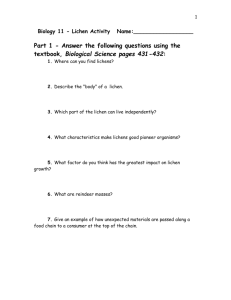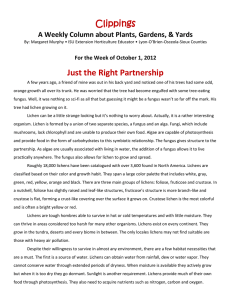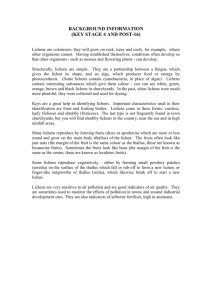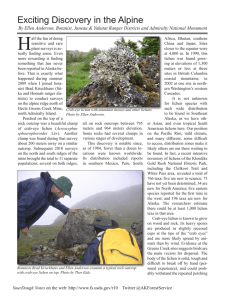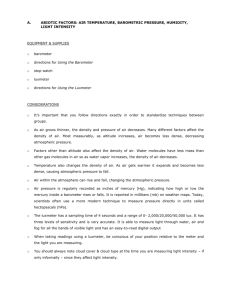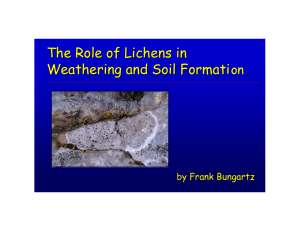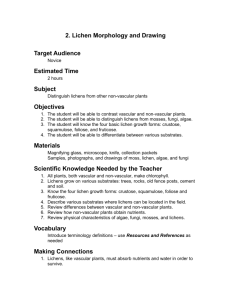Lichen - ccber
advertisement
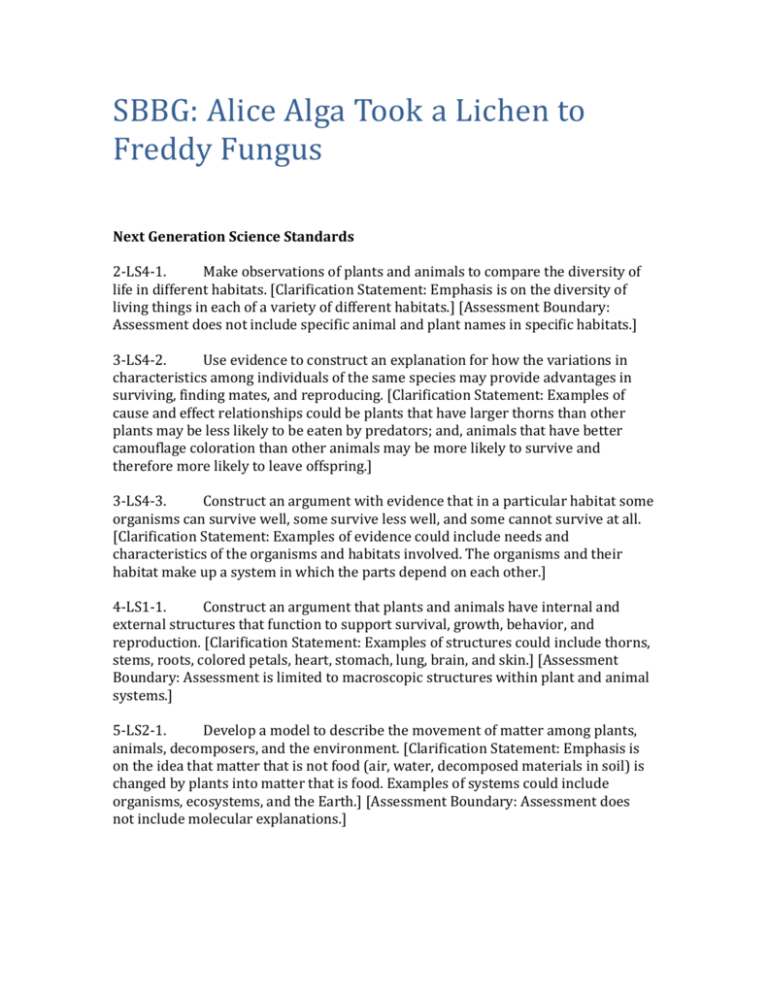
SBBG: Alice Alga Took a Lichen to Freddy Fungus Next Generation Science Standards 2-LS4-1. Make observations of plants and animals to compare the diversity of life in different habitats. [Clarification Statement: Emphasis is on the diversity of living things in each of a variety of different habitats.] [Assessment Boundary: Assessment does not include specific animal and plant names in specific habitats.] 3-LS4-2. Use evidence to construct an explanation for how the variations in characteristics among individuals of the same species may provide advantages in surviving, finding mates, and reproducing. [Clarification Statement: Examples of cause and effect relationships could be plants that have larger thorns than other plants may be less likely to be eaten by predators; and, animals that have better camouflage coloration than other animals may be more likely to survive and therefore more likely to leave offspring.] 3-LS4-3. Construct an argument with evidence that in a particular habitat some organisms can survive well, some survive less well, and some cannot survive at all. [Clarification Statement: Examples of evidence could include needs and characteristics of the organisms and habitats involved. The organisms and their habitat make up a system in which the parts depend on each other.] 4-LS1-1. Construct an argument that plants and animals have internal and external structures that function to support survival, growth, behavior, and reproduction. [Clarification Statement: Examples of structures could include thorns, stems, roots, colored petals, heart, stomach, lung, brain, and skin.] [Assessment Boundary: Assessment is limited to macroscopic structures within plant and animal systems.] 5-LS2-1. Develop a model to describe the movement of matter among plants, animals, decomposers, and the environment. [Clarification Statement: Emphasis is on the idea that matter that is not food (air, water, decomposed materials in soil) is changed by plants into matter that is food. Examples of systems could include organisms, ecosystems, and the Earth.] [Assessment Boundary: Assessment does not include molecular explanations.] Lesson Plan: Lichen Objective: Students will learn about the symbiotic relationship between fungus and alga. Students will also learn to identify some of the more common lichen and their key characteristics. Materials: KIN journal, laminated photos of common lichen and uses Preparation: Locate the large rock (Blakesley Boulder) covered in lichen located on the left side of the trail heading to the right after the entrance. Introduction: Ask students to look at the rock in front of them and see if they know what the colored patches on the rock actually are. Lichen. Procedure: Ask the students to use a magnifying glass to look closely at the algae and describe what they see. Have students count the different types of algae on the rock or on nearby trees etc. Compare the size of the smallest patch of algae with the largest patch, measure the diameter. Lichen is the result of the symbiotic relationship between fungus and alga, the fungus provides a home for the alga and the alga provides food for the fungus through photosynthesis. There are 3 main types of lichen: foliose (leafy), crustose (crusty) and fruticose (shrubby). Lichens absorb most of their nutrients from the air and rainfall and are sensitive to a variety of pollutants such as heavy metals, sulfur, radioactive elements, NO2, and ozone. How could scientists use this information? To determine if the air is clean. Lichens colonize places that have had no previous colonization such as rock surfaces. Lichens also provide food and shelter for animals. Lichens grow very slowly, one or two centimeters a year, and can live to be three thousand years old. They can also remain intact for 10,000 years…that’s a long time. Conclusion: Lichens are sensitive to pollution in the air and can tell us if the air is clear and clean. Drug companies make antibiotics from lichen substances. Some lichens make nitrogen in the air usable to plants. Lichens are homes for spiders, mites, lice and other insects. Lichens can be used as a natural dye to color wool. Animals eat lichens. They grow very slowly and can be very old.



